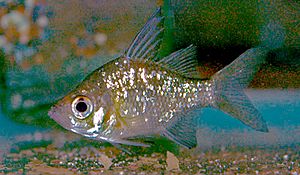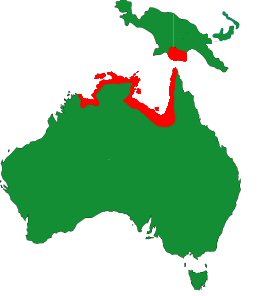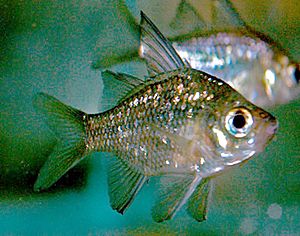Macleay's glassfish facts for kids
Quick facts for kids Macleay's glassfish |
|
|---|---|
 |
|
| Conservation status | |
| Scientific classification | |
 |
|
| Approximate distribution of A. macleayi within Australia and New Guinea | |
| Synonyms | |
|
The Ambassis macleayi, also known as Macleay's glassfish, is a small, clear freshwater fish. It lives in the northern parts of Australia and the trans-Fly River area of New Guinea.
This fish has a flat, narrow body. It usually grows to about 3.5 to 4.5 centimeters (1.4 to 1.8 inches) long. Some bigger ones can reach up to 7.7 cm (3 inches). Macleay's glassfish mostly eats tiny water fleas and other small bugs.
The International Union for Conservation of Nature (IUCN) says this fish is a "least-concern species." This means it is not currently in danger of disappearing. However, its home could be harmed by wild pigs and invasive water plants like the water hyacinth. People sometimes keep these fish in aquariums with other calm fish.
Contents
Discovering Macleay's Glassfish
A French scientist named Francis de Laporte de Castelnau first described this fish in 1878. He found it near the Gulf of Carpentaria in northern Australia. He named it Pseudoambassis macleayi.
The fish was named after William Macleay, who helped a lot with studying and naming fish. Castelnau thought this fish was special because it didn't have a certain spine near its top fin. Later, other scientists moved it into the Ambassis group.
What Does Macleay's Glassfish Look Like?
Macleay's glassfish is a medium-sized fish that can grow up to 7.7 cm (3 inches) long. Most are between 3.5 and 4.5 cm (1.4 to 1.8 inches). Male fish are usually larger than females.
Its body is quite deep, almost half as deep as it is long. It has a big head and an upper jaw that goes past its large eye. The first top fin is tall.
The fish's color can be partly clear and olive-green. It can also be dark brown-green or golden-yellow. Its belly is usually lighter. The edges of its scales are darker, making a net-like pattern, especially on its upper body.
Its tail, bottom, and top fins are dark with clear or white spines. The tail and bottom fins might have a thin reddish or dark edge. Its side fins are clear, sometimes with a dark spot near their base.
You can tell A. macleayi apart from other similar fish by its deep body, many gill rakers (parts that help it breathe), a broken side line, and the dark spot on its side fins.
Where Macleay's Glassfish Lives
Macleay's glassfish lives in northern Australia. You can find it from the Carson River in Western Australia to the Jardine River in Cape York. It also lives in the trans-Fly region of New Guinea. This area is a low-lying land with grasslands.
These fish prefer to live in streams and swamps. During the dry season, they might move to muddy lagoons. In the wet season, they spread out into rivers and streams. They usually live in places with lots of plants, wood, and fallen leaves. They are rarely found deeper than 1 meter (3 feet).
Even though different groups of these fish can connect during the wet season, they don't move much between different river systems. This means that if a group is disturbed, it's hard for them to get new fish from other areas. Because of this, scientists suggest that efforts to protect them should focus on each river system separately.
Life Cycle and Reproduction
Macleay's glassfish can lay many eggs. A large female can produce about 2,300 tiny eggs, which are only about 0.3 mm (0.01 inches) wide. These eggs get bigger when they touch water.
The fish lay their eggs on water plants. The eggs stick to the plants as they sink. They lay hundreds of eggs in batches over about a week. The eggs hatch in 21–23 hours if the water is between 25–28°C (77–82°F).
When they first hatch, the baby fish (larvae) are very small, about 1.5–1.6 mm (0.06 inches). They grow quickly. After three days, they start to eat, and after 18 days, they are about 10 mm (0.4 inches) long. Some reports say they become adults at 3 months old, while others say 12 months. They can lay eggs all year, but especially at the start of the wet season.
What Macleay's Glassfish Eats
Macleay's glassfish mainly eats tiny crustaceans, which are like tiny water bugs. About 70% of their diet is made up of these "water fleas" called cladocerans. About 20% of their food is aquatic insects, especially midge larvae.
However, in some rivers, like the Normanby River, their diet is different. There, they eat more midge larvae and fewer water fleas. These fish can also eat other things like insects that fall into the water, small fish, and even plant matter.
Studies show that Macleay's glassfish usually stays in areas with lots of cover, like plants, to hide from bigger fish that might eat them. They are often found in cloudy water, which also helps them hide.
Macleay's Glassfish and People
People sometimes keep Macleay's glassfish in aquariums. They need water temperatures between 22–34°C (72–93°F). The water's pH should be between 6.0 and 9.7. In Queensland, Australia, you can only keep up to 20 of these fish.
These fish are not aggressive. They get along well with other fish in a community tank, as long as the other fish are not small enough to be eaten. Since they are schooling fish, it's best to keep them in a group of six or more. It's also good to feed them live food sometimes, like brine shrimp or daphnia.
The Queensland Government suggests using Macleay's glassfish to help control mosquitoes in dams. In 1991, a study found that this fish was good for testing how toxic uranium was in freshwater in northern Australia.
Protecting Macleay's Glassfish
The International Union for Conservation of Nature (IUCN) lists Macleay's glassfish as a "least concern" species. This means it's not currently at high risk. The fish can handle different water conditions and lives in many places, which helps its populations stay strong.
However, there are still some dangers. Wild pigs can stir up waterways, making the water cloudy. This reduces the light for water plants, which the fish need. Also, invasive plants like water hyacinth can take over their habitat. These things could harm the fish in the future.
See also
 In Spanish: Ambassis macleayi para niños
In Spanish: Ambassis macleayi para niños
Images for kids




